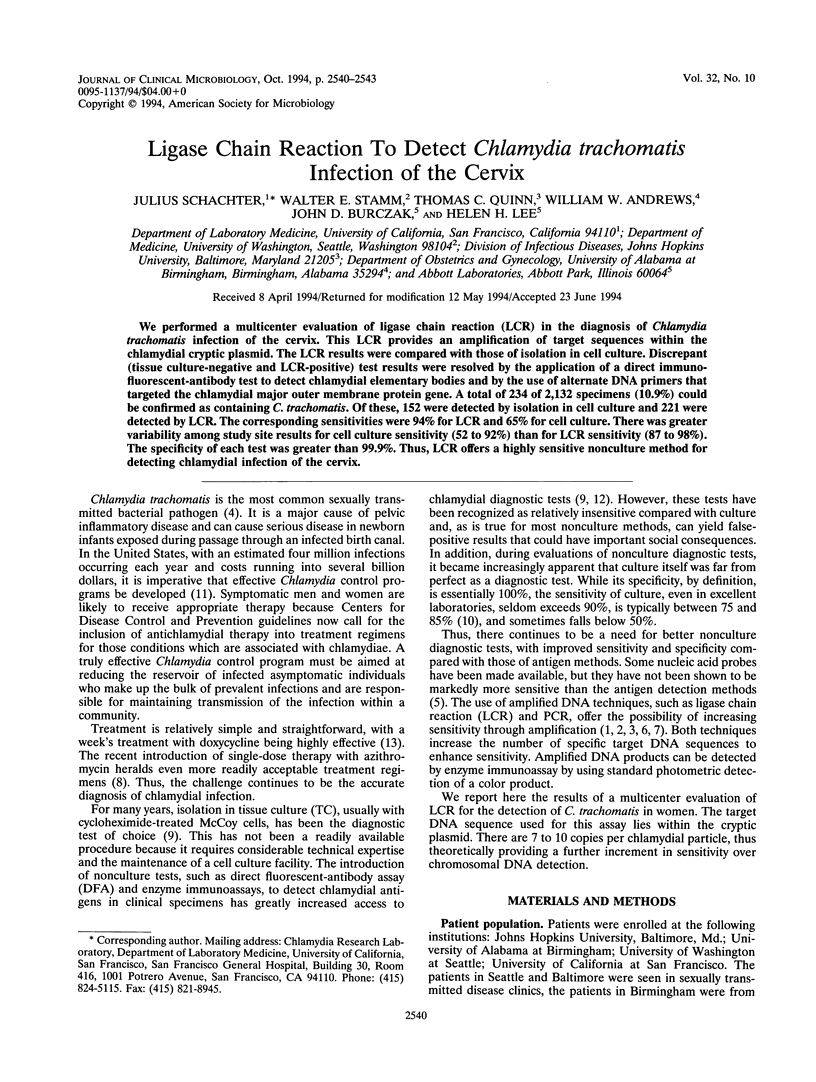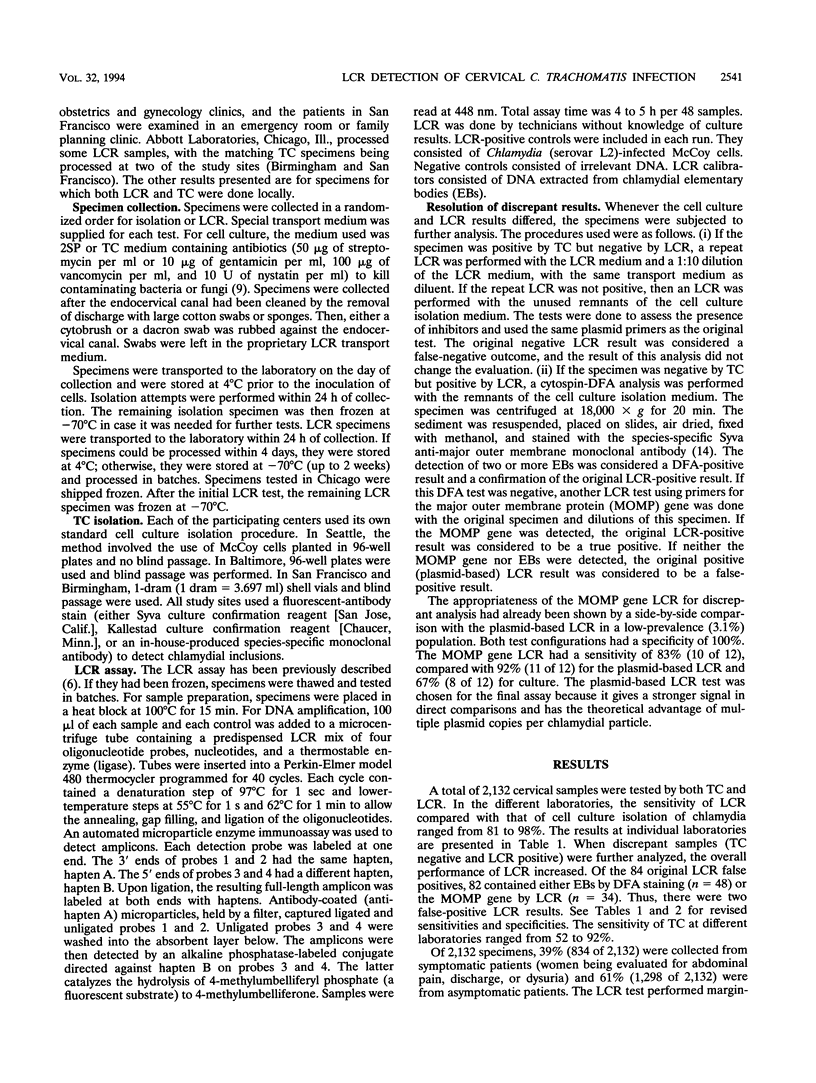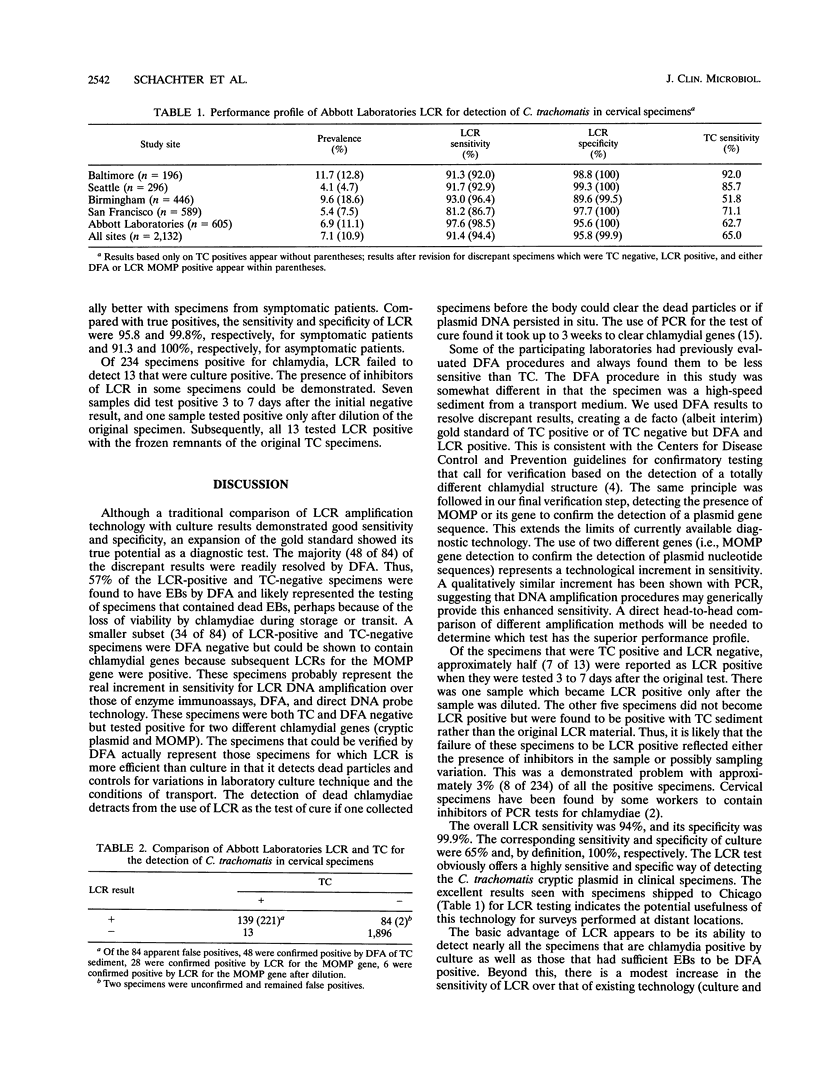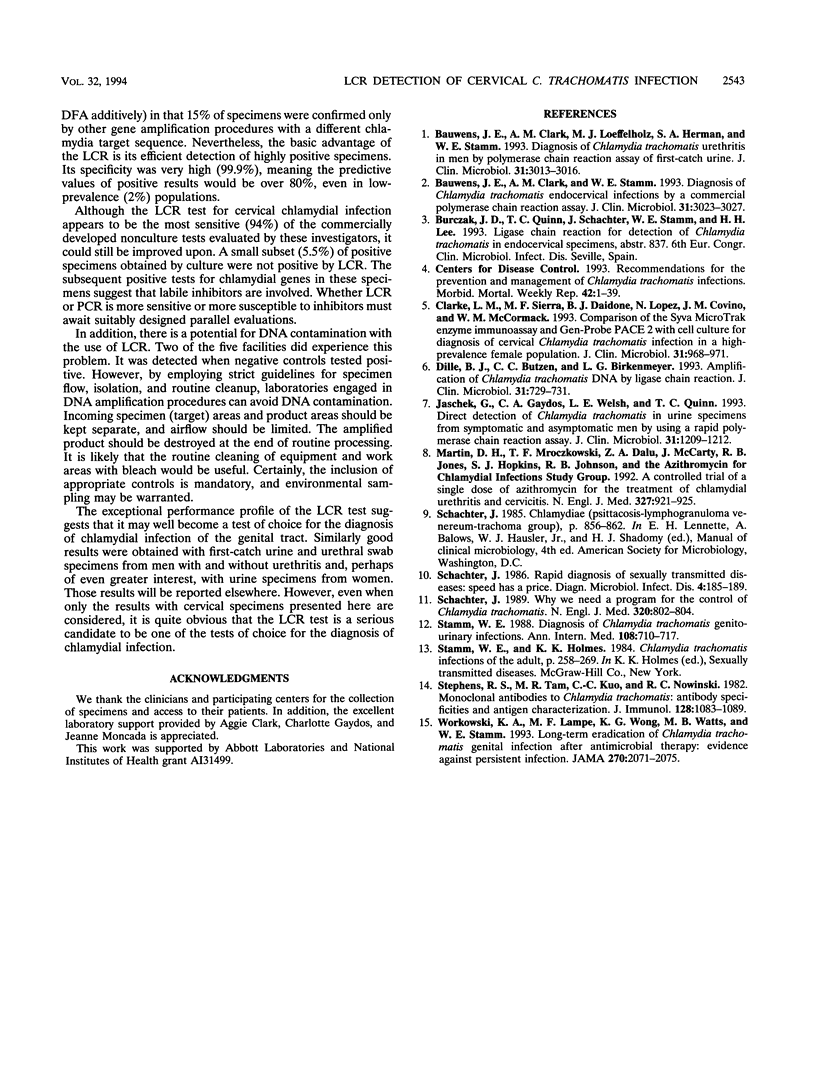Abstract
We performed a multicenter evaluation of ligase chain reaction (LCR) in the diagnosis of Chlamydia trachomatis infection of the cervix. This LCR provides an amplification of target sequences within the chlamydial cryptic plasmid. The LCR results were compared with those of isolation in cell culture. Discrepant (tissue culture-negative and LCR-positive) test results were resolved by the application of a direct immunofluorescent-antibody test to detect chlamydial elementary bodies and by the use of alternate DNA primers that targeted the chlamydial major outer membrane protein gene. A total of 234 of 2,132 specimens (10.9%) could be confirmed as containing C. trachomatis. Of these, 152 were detected by isolation in cell culture and 221 were detected by LCR. The corresponding sensitivities were 94% for LCR and 65% for cell culture. There was greater variability among study site results for cell culture sensitivity (52 to 92%) than for LCR sensitivity (87 to 98%). The specificity of each test was greater than 99.9%. Thus, LCR offers a highly sensitive nonculture method for detecting chlamydial infection of the cervix.
Full text
PDF



Selected References
These references are in PubMed. This may not be the complete list of references from this article.
- Bauwens J. E., Clark A. M., Loeffelholz M. J., Herman S. A., Stamm W. E. Diagnosis of Chlamydia trachomatis urethritis in men by polymerase chain reaction assay of first-catch urine. J Clin Microbiol. 1993 Nov;31(11):3013–3016. doi: 10.1128/jcm.31.11.3013-3016.1993. [DOI] [PMC free article] [PubMed] [Google Scholar]
- Bauwens J. E., Clark A. M., Stamm W. E. Diagnosis of Chlamydia trachomatis endocervical infections by a commercial polymerase chain reaction assay. J Clin Microbiol. 1993 Nov;31(11):3023–3027. doi: 10.1128/jcm.31.11.3023-3027.1993. [DOI] [PMC free article] [PubMed] [Google Scholar]
- Clarke L. M., Sierra M. F., Daidone B. J., Lopez N., Covino J. M., McCormack W. M. Comparison of the Syva MicroTrak enzyme immunoassay and Gen-Probe PACE 2 with cell culture for diagnosis of cervical Chlamydia trachomatis infection in a high-prevalence female population. J Clin Microbiol. 1993 Apr;31(4):968–971. doi: 10.1128/jcm.31.4.968-971.1993. [DOI] [PMC free article] [PubMed] [Google Scholar]
- Dille B. J., Butzen C. C., Birkenmeyer L. G. Amplification of Chlamydia trachomatis DNA by ligase chain reaction. J Clin Microbiol. 1993 Mar;31(3):729–731. doi: 10.1128/jcm.31.3.729-731.1993. [DOI] [PMC free article] [PubMed] [Google Scholar]
- Jaschek G., Gaydos C. A., Welsh L. E., Quinn T. C. Direct detection of Chlamydia trachomatis in urine specimens from symptomatic and asymptomatic men by using a rapid polymerase chain reaction assay. J Clin Microbiol. 1993 May;31(5):1209–1212. doi: 10.1128/jcm.31.5.1209-1212.1993. [DOI] [PMC free article] [PubMed] [Google Scholar]
- Martin D. H., Mroczkowski T. F., Dalu Z. A., McCarty J., Jones R. B., Hopkins S. J., Johnson R. B. A controlled trial of a single dose of azithromycin for the treatment of chlamydial urethritis and cervicitis. The Azithromycin for Chlamydial Infections Study Group. N Engl J Med. 1992 Sep 24;327(13):921–925. doi: 10.1056/NEJM199209243271304. [DOI] [PubMed] [Google Scholar]
- Schachter J. Rapid diagnosis of sexually transmitted diseases--speed has a price. Diagn Microbiol Infect Dis. 1986 Mar;4(3):185–189. doi: 10.1016/0732-8893(86)90097-0. [DOI] [PubMed] [Google Scholar]
- Schachter J. Why we need a program for the control of Chlamydia trachomatis. N Engl J Med. 1989 Mar 23;320(12):802–804. doi: 10.1056/NEJM198903233201210. [DOI] [PubMed] [Google Scholar]
- Stamm W. E. Diagnosis of Chlamydia trachomatis genitourinary infections. Ann Intern Med. 1988 May;108(5):710–717. doi: 10.7326/0003-4819-108-5-710. [DOI] [PubMed] [Google Scholar]
- Stephens R. S., Tam M. R., Kuo C. C., Nowinski R. C. Monoclonal antibodies to Chlamydia trachomatis: antibody specificities and antigen characterization. J Immunol. 1982 Mar;128(3):1083–1089. [PubMed] [Google Scholar]
- Workowski K. A., Lampe M. F., Wong K. G., Watts M. B., Stamm W. E. Long-term eradication of Chlamydia trachomatis genital infection after antimicrobial therapy. Evidence against persistent infection. JAMA. 1993 Nov 3;270(17):2071–2075. [PubMed] [Google Scholar]


